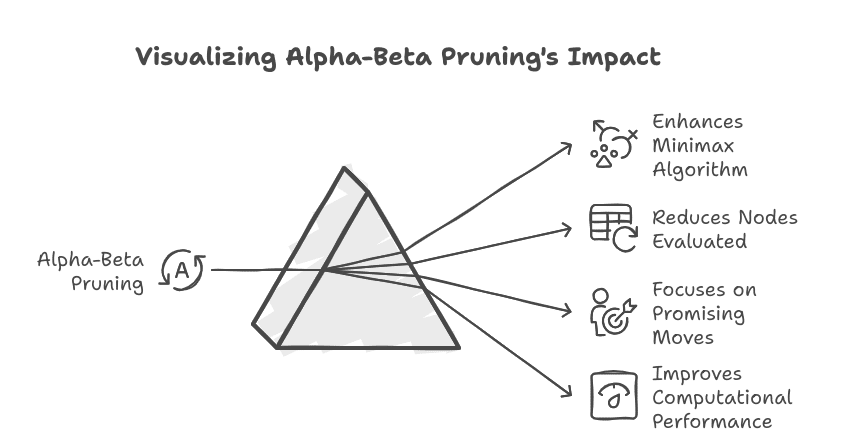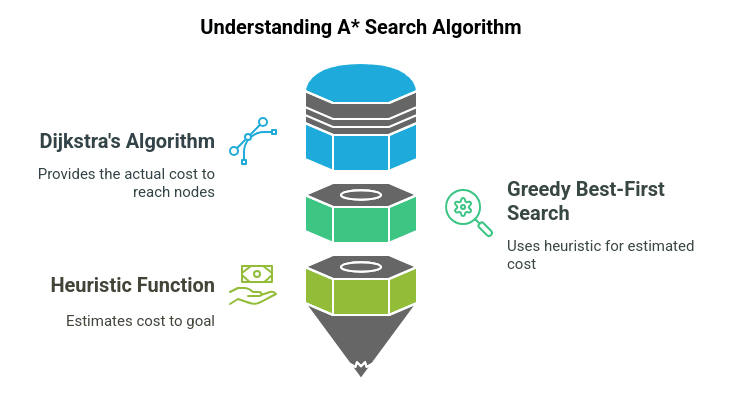Introduction
The word ‘pruning’ means cutting down branches and leaves. In Artificial Intelligence, Alpha-beta pruning is the pruning of useless branches in decision trees. This alpha-beta pruning algorithm was discovered independently by researchers in the 1900s.
Alpha Beta Pruning is a search optimization technique that improves the performance of the minimax algorithm. The minimax algorithm is a decision-making process commonly used in two-player, zero-sum games like chess. In such games, one player aims to maximize their score while the other seeks to minimize it.
The minimax algorithm operates by recursively exploring all possible game states (represented as a tree structure) and assigning values to the leaf nodes based on the potential outcomes of the game.
The algorithm then propagates these values up the tree to find the optimal move. However, as the complexity of the game increases, the number of possible states grows exponentially, leading to very high computational costs.
This is where Alpha Beta Pruning becomes crucial. It reduces the number of nodes the minimax algorithm needs to evaluate by "pruning" branches that cannot influence the final decision.
By eliminating unnecessary computations it simplifies the decision-making process, enabling faster and more efficient evaluations. As a result, Alpha Beta Pruning is practical for real-time applications, such as game-playing AI, where speed and efficiency are critical.
Post Graduate Program in Data Science with Generative AI: Applications to Business
Learn how to turn data into strategy in this UT Data Science and Business Analytics Course — now with a focus on Generative AI. Gain practical experience through 7 hands-on projects over a 7-month duration.
How Alpha Beta Pruning Works
The key idea behind Alpha Beta Pruning is to avoid evaluating branches of the game tree that cannot influence the final decision based on the values already discovered during the search. It achieves this using two values: Alpha and Beta.
Alpha and Beta Values
- Alpha represents the best (highest-value) value that the maximizing player (usually the AI) can guarantee so far. It acts as a lower bound. The initial value of alpha is −∞.
- Beta represents the best (lowest-value) value that the minimizing player (the opponent) can guarantee so far. It acts as an upper bound. The initial value of alpha is +∞.
The Pruning Process
- As the AI explores the tree, it keeps track of Alpha and Beta values. When exploring a node, it compares the node's value against these values.
- If, at any point, Alpha becomes greater than or equal to Beta; it means the current branch will not affect the final decision because the opponent will avoid this path in favor of a better one. As a result, this branch is pruned, and the algorithm moves on to the next branch.
- This process allows the algorithm to skip large parts of the tree, significantly reducing the number of nodes to be evaluated.
Working of Alpha-beta Pruning
1. First, we will take care of the first move. So initially, we will define the worst case α = −∞ and β = +∞. If alpha is greater than or equal to beta, we will prune the node.

2. We didn't prune it since the initial value of alpha is less than beta. Now it's turn for MAX. Therefore, we will calculate the value of alpha at node D. At node D, the value of alpha will be max (2, 3) = 3.
3. Now, node B’s turn is MIN. That means that the value of alpha beta at node B will be min (3, ∞). Therefore, alpha will be – ∞ and beta will be 3 at node B.
Next, algorithms will pass the values of α= -∞ and β= 3 to the next successor of Node B, that is node E.

4. Now it's turn for MAX. Therefore, we will search for MAX at node E. The value of alpha at E is – ∞ and will be compared with 5. So, MAX (- ∞, 5) will be 5. Thus, at node E, alpha = 5, Beta = 5.

We now know that alpha is greater than beta and is also a pruning condition, so we can prune the right successor of node E, and the algorithm will not be visited, and the value of node E will be 5.
5. In the next step, the algorithm again comes from node B to node A. The alpha of node A is changed to the max value of MAX(- ∞, 3). Now, alpha and beta at node A are (3, + ∞) and will be transmitted to node C. The same values will be transferred to node F.
6. The value of alpha will be compared to the left branch, which is 0 at node F. Now, MAX (0, 3) will be 3 and is compared with the right child (1) and MAX(3, 1) = 3 still α is 3, but the node value of F will be 1.

7. Afterward, node F will pass the node value 1 to C and compare it to the beta value at C. Now it's turn for MIN. So, MIN (+ ∞, 1) will be 1. Now, at node C, α = 3, β= 1, and alpha is greater than beta, which again satisfies the pruning condition. Then, the successor of node C, G, will be pruned, and the algorithm did not calculate the whole subtree G.

Now, C will return its node value to A, and A will calculate MAX(1, 3), resulting in 3.

This above-represented tree is the final tree that has nodes that are computed and nodes that are not computed. Therefore, in this example, the optimal value of the maximizer would be 3.
Key Benefits of Alpha Beta Pruning in AI
When the game trees are complex, some important advantages of Alpha Beta Pruning for AI decision-making algorithms come into play.
1. Improved Efficiency
By pruning unnecessary branches, Alpha Beta Pruning significantly reduces the amount of computation required. The algorithm can focus on evaluating only the most relevant parts of the tree, making decision-making much faster.
2. Reduced Time Complexity
Without pruning, the minimax algorithm has a time complexity of O(b^d), where b represents the branching factor (the number of possible moves) and d is the depth of the tree. With Alpha Beta Pruning, the time complexity can be reduced to O(b^(d/2)) in the best case, enabling the AI to explore deeper levels of the tree much more efficiently.
3. Scalability
As AI applications become more complex and require deeper search trees (e.g., in chess or Go), Alpha Beta Pruning makes exploring these larger search spaces feasible. The ability to prune unnecessary branches means that AI systems can handle more complex decision-making tasks in real time.
Applications of Alpha Beta Pruning in AI
Alpha Beta Pruning is widely used in AI applications where decision trees need to be explored efficiently. Some key applications include:
1. Game AI
In strategic games like chess, checkers, or Go, Alpha Beta Pruning becomes crucial for enabling AI to evaluate millions of possible moves in real-time.
Games like Stockfish (chess) and AlphaGo (Go) use Alpha Beta Pruning as a core component of their decision-making algorithms, enabling them to compete with human players at the highest level.
Curious about the role of AI in gaming? Learn from our article on How AI is Changing the Gaming Industry.
2. Autonomous Systems and Robotics
Decision trees are used frequently in robotics automation for real time decisions on movement, navigation, and task execution. Alpha Beta Pruning aids in quickly evaluating different paths and strategies through robots, which helps them respond faster in a dynamic environment.
3. Models on Financial and Optimization
Decision trees are also used in financial forecasting, portfolio optimization, and supply chain management through AI systems, especially in evaluating different scenarios and making predictions. To make more timely decisions, these systems could use Alpha Beta Pruning to process large datasets.
PG Program in AI & Machine Learning
Master AI with hands-on projects, expert mentorship, and a prestigious certificate from UT Austin and Great Lakes Executive Learning.
Limitations of Alpha Beta Pruning used in AI
While Alpha Beta Pruning is a powerful technique, it does have some limitations:

- Branching Factor: The effectiveness of Alpha Beta Pruning depends on the branching factor of the game tree. If the branching factor is very high, pruning may not reduce computation enough to improve performance significantly.
- Assumes Optimal Play: Alpha Beta Pruning assumes that both players are playing optimally, which may not always be true in real-world situations, especially when human players are involved.
Real-World Example: AlphaGo and Chess Engines
Two prominent examples of Alpha Beta Pruning in action are AlphaGo and modern chess engines.
- AlphaGo, the AI developed by DeepMind, used a combination of Monte Carlo Tree Search (MCTS) and Alpha Beta Pruning to evaluate possible moves in the game of Go. By pruning unnecessary branches and focusing on the most promising moves, AlphaGo was able to defeat world champions.
- Chess engines like Stockfish use Alpha Beta Pruning to evaluate millions of potential moves per second. This allows them to calculate the best possible move in real time, making them capable of competing with and defeating top human players.
Conclusion
Alpha Beta Pruning is an essential optimization technique for AI decision-making algorithms. By significantly reducing the number of nodes that need to be evaluated, it makes complex decision-making processes more efficient and feasible, even for large-scale problems.
Whether in game-playing AI, robotics, or optimization systems, Alpha Beta Pruning is a cornerstone of AI algorithms that require fast and accurate decision-making.
To dive deeper into AI, explore our courses on Artificial Intelligence.
Further Reading:






